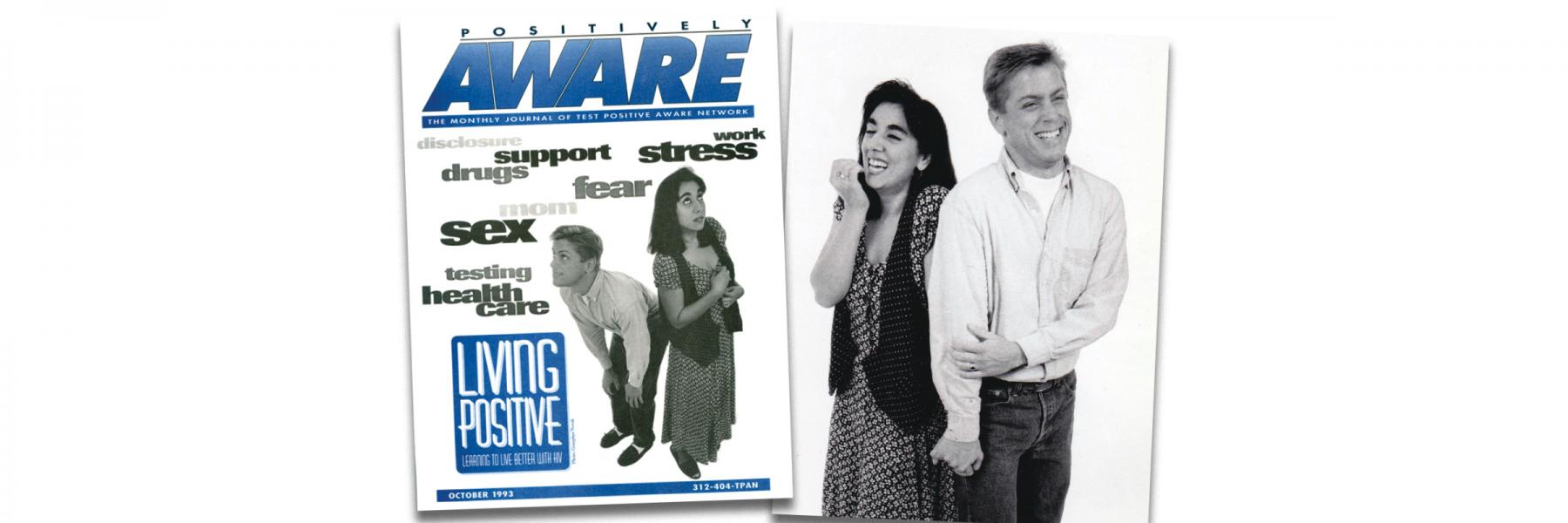
This year marks 30 years of Positively Aware (PA) magazine. What started out as TPA News, a local newsletter for TPAN (the HIV service organization that publishes PA), became Positively Aware and went national with the launch of the November 1990 issue.
As someone who accessed services at TPAN a few years after testing positive in 1989, I would get the magazine in the mail. There were things about PA that I immediately identified with. I loved the campiness of the illustrations (see Camp Humor, 1993), and the fact that it was sex positive. Even though death was all around us in those early days of the epidemic, PA somehow made it less morbid and depressing. This was still the pre-protease inhibitor (and pre-internet) era, but it opened up my thinking and made me believe that I could still live a “normal” life. I loved that PA covered every aspect of people’s lives—spirituality, sex, stress, disclosure—and all in a very approachable way. I came to understand through the imagery and content of PA that I could still have a fulfilling life, and sex life, in the age of AIDS, which is very important to someone who has been handed what at the time was a death sentence. It was fun to read the magazine, despite the serious topic.
We’ve seen many changes in Positively Aware over the years, going from a local newsletter to a national monthly magazine putting out 16 issues a year, including four quarterlies that were customized for 10 different cities, another quarterly publication in Spanish that ran for several years, and ongoing special focus issues on topics such as pharmacokinetics, HIV and aging, and PrEP. We’ve always remained dedicated to our highest purpose, and that is to deliver cutting-edge information to people living with and affected by HIV, in a way that’s easy to understand.
This year as we mark our 30th anniversary of publishing, we’ll be looking back at some of the stories and people who helped make Positively Aware what it is today: a vital resource for so many. In this issue you’ll hear from former associate editor Keith R. Green as he introduces a reprint of a very personal Editor’s Note from the late Charles Clifton, written in the days following 9/11. Author and sociology professor Celeste Watkins-Hayes reflects on her time at TPAN in 2005 when she began her research on women living with HIV that culminated in her new book, Remaking A Life: How Women Living with HIV/AIDS Confront Inequality. And you’ll see some of those campy images and covers from previous issues.
While some things have changed, many remain the same. Prevention of vertical (mother-to-child) transmission of HIV, one of the biggest successes of HIV treatment in the history of the epidemic, is the subject of our cover story “Born Free,” by Michelle Simek. The story is a very personal account of one woman born with HIV who gave birth to a child who is HIV-negative.
For the October 1993 issue (right) our staff needed someone to stand in for the cover shoot at the last minute, so I volunteered. I posed with Gina, who let me borrow her loafers because I had worn white tennis shoes that day (hey, it was the ’90s)—hence the white socks. Gina, now a long-term survivor, was one of the success stories and a participant in the ACTG 076 study which showed that giving AZT to pregnant women with HIV was effective in preventing transmission of the virus to the infant. Her son, who was born HIV-negative, is now a healthy and thriving young man.
Publishing is a collaborative process, and this magazine would not be possible without the contributions of many writers who donate their services, and the talented Positively Aware team including Associate Editor Enid Vázquez, Creative Director Rick Guasco, Advertising Manager Lorraine Hayes, Hepatitis C Editor Andrew Reynolds, and proofreader Jason Lancaster.
I never expected a volunteer position to turn into a career and my life’s work, but somehow it did and for that I’m grateful. I love the work that I do, and the people I work with. I’m proud of how we’ve always been able to accomplish so much with so little. And the best moments are when we occasionally get a letter or a note from someone thanking us for a story or for something that we wrote, and how it touched or helped them in their life. That is what makes it all worthwhile.
Take care of yourself, and each other.


